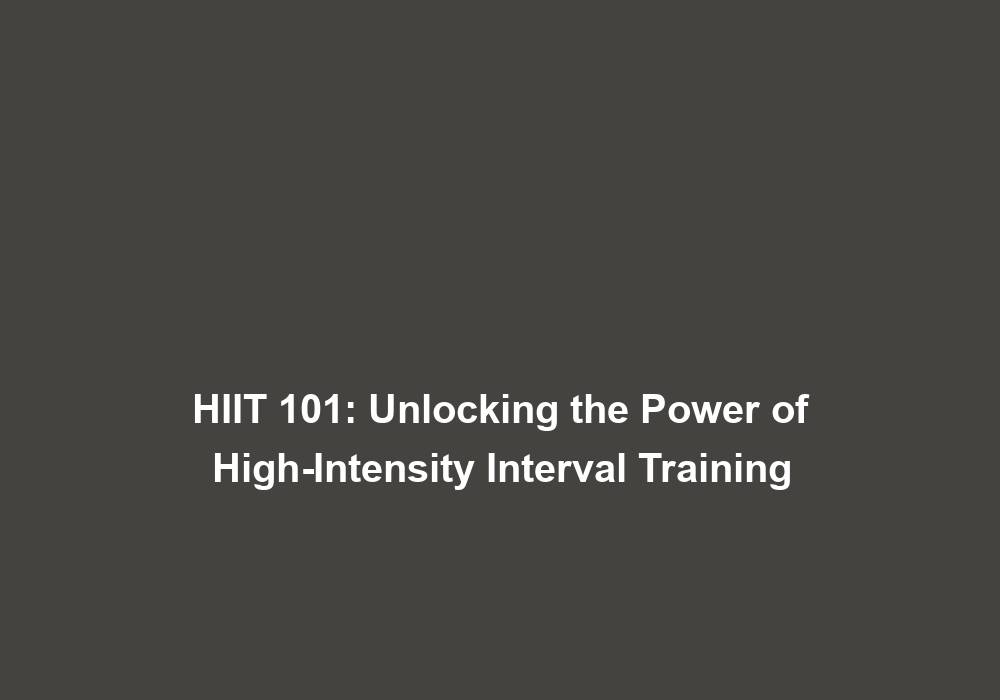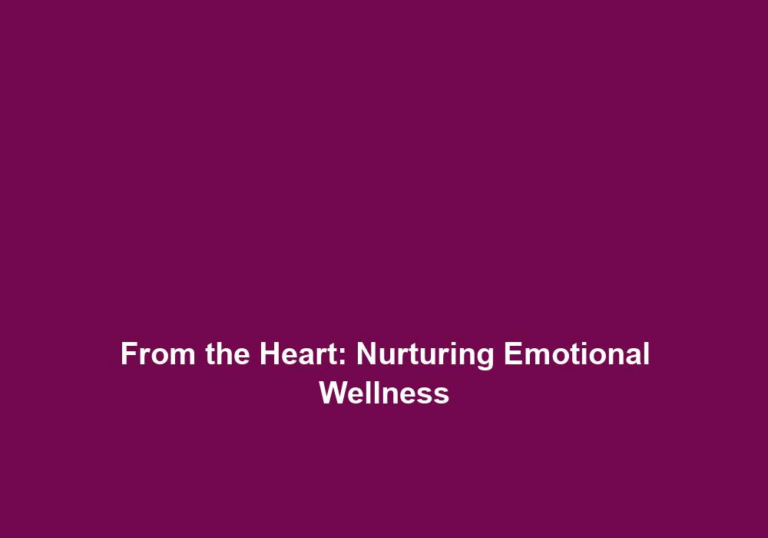HIIT 101: Unlocking the Power of High-Intensity Interval Training
High-Intensity Interval Training (HIIT) has gained immense popularity in the fitness world due to its effectiveness in improving overall fitness levels and burning calories in a short amount of time. This comprehensive guide aims to provide you with a detailed understanding of HIIT, including its benefits, how it works, and tips to incorporate it into your fitness routine.
What is High-Intensity Interval Training?
High-Intensity Interval Training is a form of cardiovascular exercise that alternates between intense bursts of exercise and short recovery periods. Unlike traditional moderate-intensity cardio exercises, HIIT pushes you to your maximum effort during the high-intensity intervals, elevating your heart rate and challenging your muscles. The recovery periods allow your body to catch its breath before the next intense interval.
Benefits of HIIT
-
Efficiency: One of the main advantages of HIIT is its time efficiency. Due to the high-intensity nature of the workout, you can achieve significant results in a shorter amount of time compared to traditional moderate-intensity cardio exercises. This is especially beneficial for individuals with busy schedules who struggle to find time for lengthy workouts.
-
Burns More Calories: HIIT workouts have been shown to increase your metabolic rate, leading to the continued burning of calories even after you’ve finished exercising. This phenomenon is known as the afterburn effect or excess post-exercise oxygen consumption (EPOC). The intense bursts of exercise in HIIT create an oxygen debt that your body needs to repay, resulting in a higher calorie burn compared to steady-state cardio exercises.
-
Improves Cardiovascular Health: HIIT improves cardiovascular health by challenging your heart and lungs, leading to increased cardiovascular endurance and improved oxygen consumption. The repeated cycles of intense exercise followed by short recovery periods strengthen your heart, making it more efficient at pumping blood throughout your body. This can help reduce the risk of cardiovascular diseases such as heart attack and stroke.
-
Preserves Muscle Mass: One common concern with traditional cardio exercises is the potential loss of muscle mass. However, HIIT workouts are designed to preserve muscle mass while burning fat. By incorporating strength exercises into your high-intensity intervals, you can stimulate muscle growth and develop lean muscle mass. This is particularly beneficial for individuals who want to improve their body composition and achieve a toned physique.
-
No Equipment Required: HIIT workouts can be done with minimal or no equipment, making them accessible to everyone. Bodyweight exercises like jump squats, burpees, and mountain climbers can provide an intense workout without the need for specialized equipment. This makes HIIT a convenient option for those who prefer to exercise at home or do not have access to a gym.
-
Adaptable to Any Fitness Level: HIIT workouts can be adapted to suit any fitness level. Beginners can start with shorter intervals and longer recovery periods, gradually increasing the intensity and duration as they progress. This flexibility allows individuals of all fitness levels to reap the benefits of HIIT, regardless of their current fitness level or exercise experience.
How Does HIIT Work?
During a HIIT workout, you alternate between periods of intense exercise and active recovery. The duration of each interval and the ratio of work to recovery time can vary depending on your fitness level and goals. Generally, a HIIT workout consists of the following structure:
-
Warm-up: Start your HIIT session with a warm-up to prepare your body for the upcoming intense exercises. This can include light cardio exercises like jogging, jumping jacks, or dynamic stretches. A proper warm-up increases blood flow to your muscles, raises your body temperature, and enhances your range of motion, reducing the risk of injury.
-
High-Intensity Interval: Choose an exercise that challenges your cardiovascular system and pushes your muscles to their limits. This can include exercises like sprints, jumping lunges, or kettlebell swings. Perform the exercise at maximum effort for a specific amount of time, typically ranging from 20 seconds to 1 minute. Push yourself to the limit during these intervals, aiming to reach your maximum heart rate and experience a significant level of exertion.
-
Active Recovery: After the high-intensity interval, allow your body to recover by performing a low-intensity exercise or rest. This can include walking, jogging at a slower pace, or performing less intense bodyweight exercises. The recovery period is usually shorter than the high-intensity interval, ranging from 10 seconds to 45 seconds. Use this time to catch your breath, lower your heart rate, and prepare for the next intense interval.
-
Repeat: Continue alternating between high-intensity intervals and active recovery periods for a predetermined number of rounds or a specific duration. Aim for a total HIIT workout time of 20-30 minutes, including warm-up and cool-down. The number of intervals and the duration of the workout can be adjusted based on your fitness level and time availability. Gradually increase the intensity or duration of your intervals as you become more comfortable and stronger.
-
Cool-down: After completing the HIIT workout, allow your body to gradually return to its normal state by cooling down. This can involve static stretching exercises to increase flexibility and prevent muscle soreness. Cooling down helps remove waste products from your muscles, reduces the risk of muscle cramps, and promotes a faster recovery.
Tips for Incorporating HIIT into Your Fitness Routine
-
Start Slow: If you’re new to HIIT, start with shorter intervals and longer recovery periods. Gradually increase the intensity and duration as your fitness level improves. This allows your body to adapt to the demands of high-intensity exercise and reduces the risk of overexertion or injury.
-
Listen to Your Body: Pay attention to your body’s signals and adjust the intensity or duration of the intervals if needed. It’s important to challenge yourself, but not at the expense of proper form or risking injury. If you experience sharp pain or discomfort during a HIIT workout, it’s essential to stop and seek medical advice if necessary.
-
Combine Strength and Cardio: Incorporate both cardiovascular exercises and strength exercises into your HIIT workouts for maximum benefits. This combination will help improve your cardiovascular endurance while building strength and muscle. Include exercises like push-ups, squats, lunges, and planks to target different muscle groups and enhance overall fitness.
-
Schedule Rest Days: HIIT workouts are intense and put a significant strain on your body. Make sure to schedule rest days in between sessions to allow for proper recovery and muscle repair. Rest days are crucial for preventing overtraining and reducing the risk of burnout or injury. Use these days to engage in low-impact activities like yoga or gentle stretching to promote active recovery.
-
Stay Hydrated: Hydration is crucial during HIIT workouts. Drink plenty of water before, during, and after your session to prevent dehydration and optimize performance. Proper hydration helps regulate your body temperature, lubricate your joints, and transport nutrients to your muscles. If you’re exercising in a hot or humid environment, consider replenishing electrolytes through sports drinks or coconut water.
-
Progress Gradually: As you become more comfortable with HIIT, gradually increase the intensity or duration of your intervals to continue challenging your body and avoid plateauing. This progressive overload principle stimulates further improvements in cardiovascular fitness, muscle strength, and endurance. Keep a record of your workouts to track your progress and set new goals.
In conclusion, High-Intensity Interval Training (HIIT) is an effective and time-efficient workout method that offers numerous benefits, including improved cardiovascular health, increased calorie burn, and the preservation of muscle mass. By incorporating HIIT into your fitness routine and following the tips provided, you can unlock the power of HIIT and take your fitness journey to the next level.
Note: The content above has been written in Markdown format as per your request.







